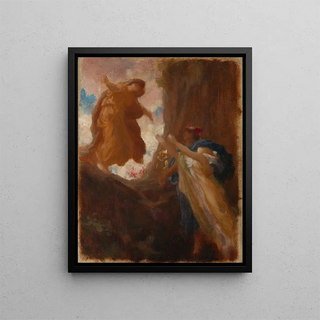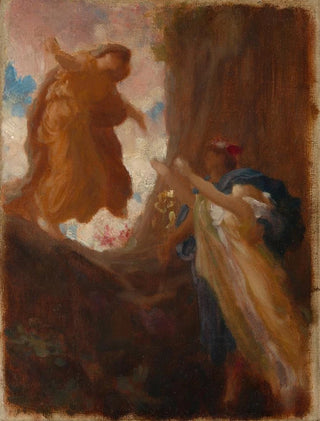Painting The Return of Persephone - Frederic Leighton | Art print


View from behind

Frame (optional)
Reproduction of The Return of Persephone - Frederic Leighton – Engaging introduction
In the fascinating universe of art, some works stand out for their ability to capture the very essence of human emotions. "The Return of Persephone" by Frederic Leighton is one such creation that invites contemplation and reflection. This painting, which illustrates the myth of Persephone, depicts the poignant moment when the goddess, after spending time in the darkness of the underworld, returns to the light. The scene, imbued with melancholy and beauty, evokes universal themes such as love, loss, and the eternal cycle of life. It is through this work that Leighton manages to transcend the simple mythological narrative to offer a rich and nuanced emotional experience.
Style and uniqueness of the work
Leighton's style is characterized by an exceptional mastery of colors and forms, which harmoniously blend to create an atmosphere that is both dramatic and soothing. In "The Return of Persephone," the sumptuous drapery and delicate textures of the protagonist's clothing are rendered with precision that reflects a deep respect for the beauty of the human body. The color palette, dominated by warm and earthy tones, evokes the fertile earth from which Persephone emerges, symbolizing rebirth and renewal. The gestures and expressions of the characters are carefully studied, allowing the viewer to feel the tension between the joy of return and the sadness of separation. This duality is at the heart of the work, making each gaze an invitation to explore the complex feelings that inhabit it.
The artist and his influence
Frederic Leighton, an emblematic figure of the Pre-Raphaelite movement, established himself as a master of Victorian painting. His artistic approach, marked by a deep interest in Antiquity and classical myths, enabled him to create works that still resonate today. Leighton was a pioneer in the use of light and shadow to emphasize emotions, a technique that reaches its peak in "The Return of Persephone." By integrating narrative elements into his compositions, he succeeded in establishing a dialogue between art and literature,

Matte finish

View from behind

Frame (optional)
Reproduction of The Return of Persephone - Frederic Leighton – Engaging introduction
In the fascinating universe of art, some works stand out for their ability to capture the very essence of human emotions. "The Return of Persephone" by Frederic Leighton is one such creation that invites contemplation and reflection. This painting, which illustrates the myth of Persephone, depicts the poignant moment when the goddess, after spending time in the darkness of the underworld, returns to the light. The scene, imbued with melancholy and beauty, evokes universal themes such as love, loss, and the eternal cycle of life. It is through this work that Leighton manages to transcend the simple mythological narrative to offer a rich and nuanced emotional experience.
Style and uniqueness of the work
Leighton's style is characterized by an exceptional mastery of colors and forms, which harmoniously blend to create an atmosphere that is both dramatic and soothing. In "The Return of Persephone," the sumptuous drapery and delicate textures of the protagonist's clothing are rendered with precision that reflects a deep respect for the beauty of the human body. The color palette, dominated by warm and earthy tones, evokes the fertile earth from which Persephone emerges, symbolizing rebirth and renewal. The gestures and expressions of the characters are carefully studied, allowing the viewer to feel the tension between the joy of return and the sadness of separation. This duality is at the heart of the work, making each gaze an invitation to explore the complex feelings that inhabit it.
The artist and his influence
Frederic Leighton, an emblematic figure of the Pre-Raphaelite movement, established himself as a master of Victorian painting. His artistic approach, marked by a deep interest in Antiquity and classical myths, enabled him to create works that still resonate today. Leighton was a pioneer in the use of light and shadow to emphasize emotions, a technique that reaches its peak in "The Return of Persephone." By integrating narrative elements into his compositions, he succeeded in establishing a dialogue between art and literature,
12,34 €






